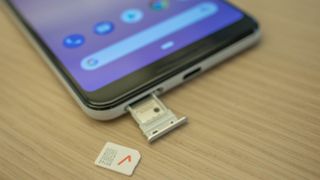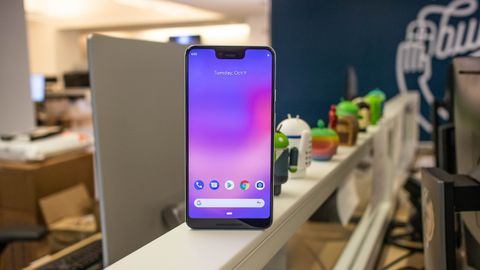Why you can trust TechRadar
Battery life
The larger Pixel 3 XL is the one to get if you’re worried about battery life. Power users will have all-day battery life, and everyone else will get closer to a day and a half from this phone.
We found its 3,430 battery capacity to be solid enough for our daily needs, even if it’s not as big as the Samsung Galaxy Note 9 battery at 4,000mAh. It’s closer to the 3,500mAh battery of the Samsung Galaxy S9 Plus, and Google has some smart power-saving modes in play here.
Adaptive battery, the new Android Pie feature to turn off power-hungry apps you don’t use, will get you more battery life, and so will downgrading the pixel count to Full HD+ instead of QHD+. You won’t notice the difference. For us, the Pixel 3 XL lasted about a dozen hours more than the smaller Google Pixel 3 with its 2,915mAh battery in real life tests.
There’s an 18W charger in the Google Pixel 3 XL box that offers faster charging speeds than a conventional USB charger, and the phone supports fast wireless charging. All Qi chargers worked fine in our testing (though slower than wired charging), and Google i selling a new Pixel Stand if you don’t have a wireless charger yet.
The minimalist-looking Pixel Stand doubles as a way to see notifications, making your Pixel 3 XL a mini Google Home Hub of sorts. But we found this stand doesn’t collapse and it’s a bit overpriced at $79. We found Mophie and Samsung’s wireless chargers cheap and easy to travel with.

Specs and performance
The Google Pixel 3 XL has been built to offer stable everyday performance, though you won’t find record-breaking speeds from its chipset and RAM configuration.
It uses the latest Qualcomm Snapdragon 845 chipset paired with 4GB of RAM at a time when Google’s rivals are making phones with 6GB and 8GB of RAM. Meanwhile, Apple’s A12 chipset and even the year-older A11 chipset beat the Snapdragon 845 chip handsdown.
Benchmarks, primarily using Geekbench 4 to test overall performance, back up what the specs suggest. The Pixel 3 XL had a multi-core score of 8,350, behind the Samsung Galaxy S9, and further behind phones like the Note 9, OnePlus 6 and iPhone XS Max.
That’s okay for two important reasons. First, we didn’t find any lag from the Pixel 3 or Pixel 3 XL in our extensive daily testing of both phones. Second, this is Google-made hardware that runs pure Android software. We therefore got snappy performance on day one and expect it to be just as good when the next operating system update rolls out, likely in August 2019.
You’re not going to notice a drop in performance now, though this phone isn’t as future-proofed as the iPhone XS, Razer Phone 2, and Asus ROG Phone. Gamers may want to look elsewhere if they’re primary focus is the best gaming phone and not the best camera phone.
Android 9.0 Pie and apps
The Google Pixel 3 XL is the best way to enjoy the Android 9.0 Pie interface changes, with a great big screen to soak in the further refined Material Design and battery life-saving benefits.
It comes with stock Android software, which contrasts with the look and feel provided by other Android smartphone makers that liberally alter Google’s software to their liking (and the disliking of ‘pure Android’ fans). Everything here is how Google has intended it.
You are in for a bit of a change, though. Google’s on-screen navigation buttons along the bottom of the handset have been downsized and require learning new gestures. The home button, for example, has been flattened-out iPhone X-style and tapping it sends you home. Swiping it up from the bottom opens up the new recent menu, and swiping all the way up reveals the new app drawer location. The back button is similar, but is a bit smaller than before.
Google’s changed UI also makes room for the Pixel 3 XL notch. The time and notification icons reside on the left side of the screen, while icons for LTE, signal strength, and battery life are flush right. The on-screen volume slider is now right-aligned, adjacent to the physical volume slider. This slider is now dedicated to media playback volume, while a small toggle button at the top of the slide dictates whether you’re in ring/vibrate/silent mode.
More than anything, you’ll get more benefit from the new behind-the-scenes effects of the Adaptive Battery Life and Adaptive Brightness settings. Adaptive Battery Life uses Google’s machine-learning smarts to figure out which apps you won’t be using in the future and then reduces their needless energy drain. Adaptive brightness takes into account your surroundings to save you some juice whenever possible.
There’s more coming to Android Pie, too. App Slices and App Actions were shown off at Google IO, and they enable shortcuts to app (and content within those apps). We’re planning to update this review when these features go live on the Google Pixel 3 XL.
Current page: Battery life, specs and software
Prev Page Three cameras Next Page Verdict and competition
Amazon Prime Video's disappearing act could point to a future without the service

Tesla Cybertruck suffers new recall for a very scary problem

'The party is over for developers looking for AI freebies' — Google terminates Gemini API free access within months amidst rumors that it could charge for AI search queries

